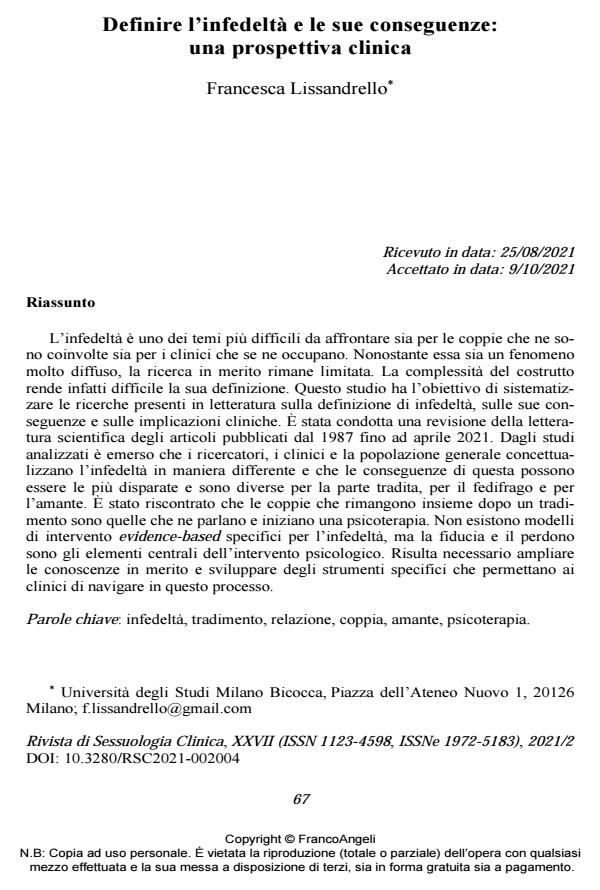Definire l’infedeltà e le sue conseguenze: una prospettiva clinica
Titolo Rivista RIVISTA DI SESSUOLOGIA CLINICA
Autori/Curatori Francesca Lissandrello
Anno di pubblicazione 2021 Fascicolo 2021/2
Lingua Italiano Numero pagine 19 P. 67-85 Dimensione file 196 KB
DOI 10.3280/RSC2021-002004
Il DOI è il codice a barre della proprietà intellettuale: per saperne di più
clicca qui
Qui sotto puoi vedere in anteprima la prima pagina di questo articolo.
Se questo articolo ti interessa, lo puoi acquistare (e scaricare in formato pdf) seguendo le facili indicazioni per acquistare il download credit. Acquista Download Credits per scaricare questo Articolo in formato PDF

FrancoAngeli è membro della Publishers International Linking Association, Inc (PILA)associazione indipendente e non profit per facilitare (attraverso i servizi tecnologici implementati da CrossRef.org) l’accesso degli studiosi ai contenuti digitali nelle pubblicazioni professionali e scientifiche
L’infedeltà è uno dei temi più difficili da affrontare sia per le coppie che ne so-no coinvolte sia per i clinici che se ne occupano. Nonostante essa sia un fenomeno molto diffuso, la ricerca in merito rimane limitata. La complessità del costrutto rende infatti difficile la sua definizione. Questo studio ha l’obiettivo di sistematiz-zare le ricerche presenti in letteratura sulla definizione di infedeltà, sulle sue conse-guenze e sulle implicazioni cliniche. È stata condotta una revisione della letteratura scientifica degli articoli pubblicati dal 1987 fino ad aprile 2021. Dagli studi analiz-zati è emerso che i ricercatori, i clinici e la popolazione generale concettualizzano l’infedeltà in maniera differente e che le conseguenze di questa possono essere le più disparate e sono diverse per la parte tradita, per il fedifrago e per l’amante. È stato riscontrato che le coppie che rimangono insieme dopo un tradimento sono quelle che ne parlano e iniziano una psicoterapia. Non esistono modelli di interven-to evidence-based specifici per l’infedeltà, ma la fiducia e il perdono sono gli ele-menti centrali dell’intervento psicologico. Risulta necessario ampliare le conoscen-ze in merito e sviluppare degli strumenti specifici che permettano ai clinici di navi-gare in questo processo.
Parole chiave: infedeltà, tradimento, relazione, coppia, amante, psicoterapia.
Francesca Lissandrello, Definire l’infedeltà e le sue conseguenze: una prospettiva clinica in "RIVISTA DI SESSUOLOGIA CLINICA" 2/2021, pp 67-85, DOI: 10.3280/RSC2021-002004